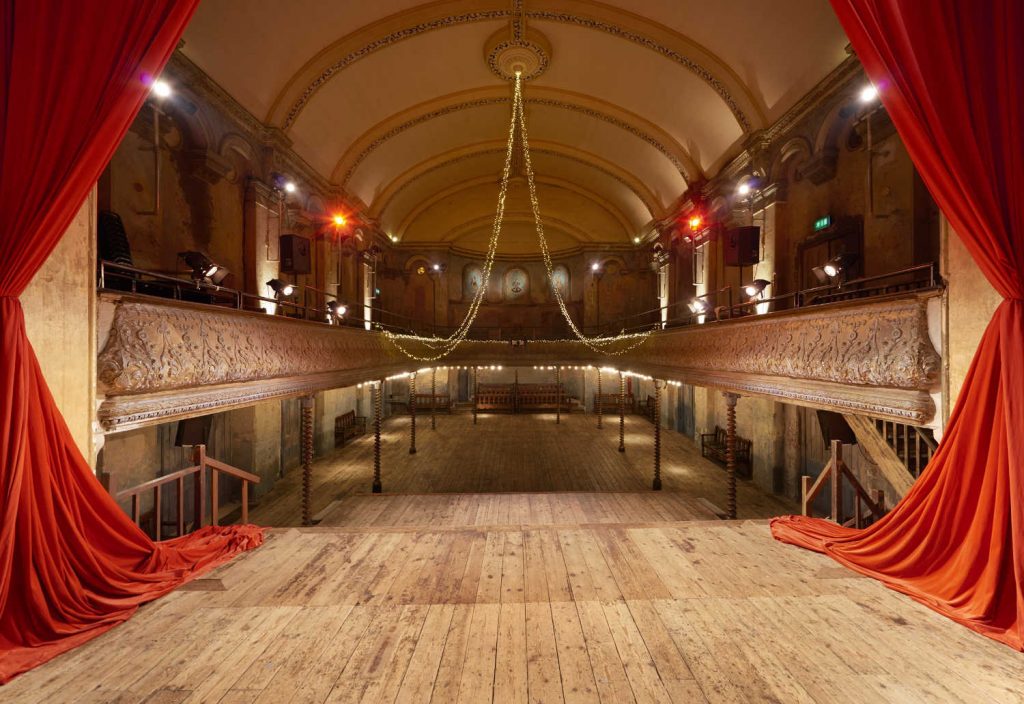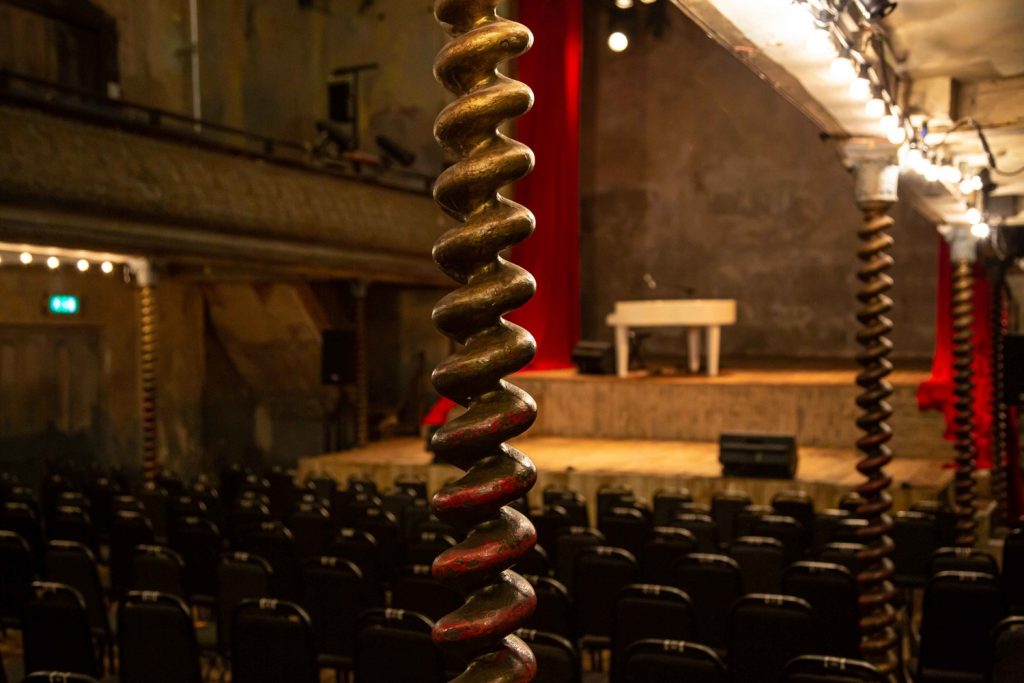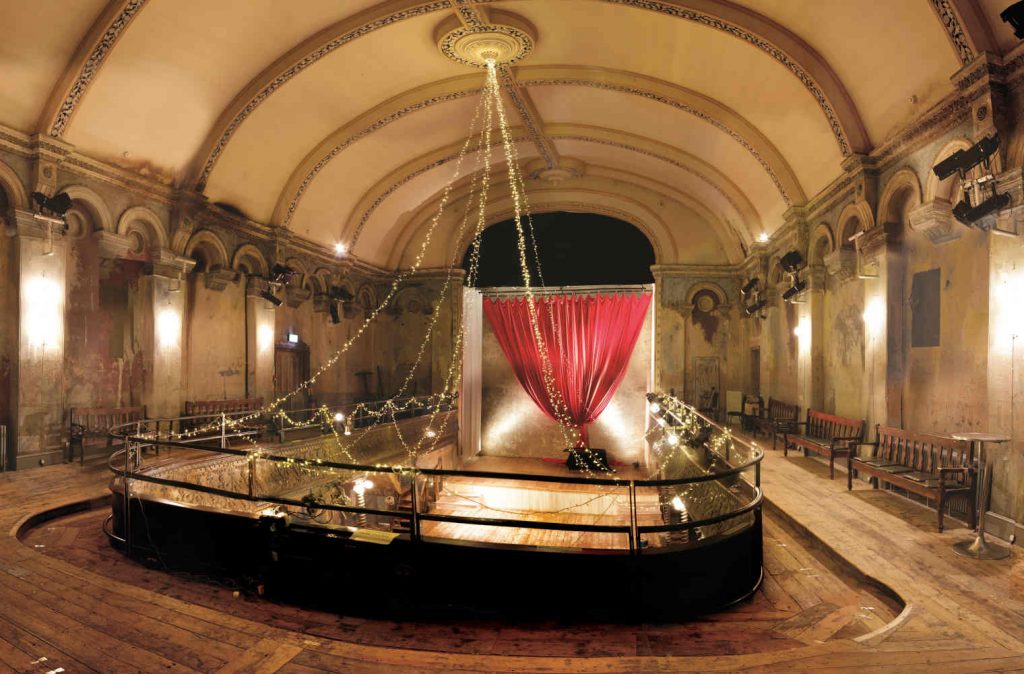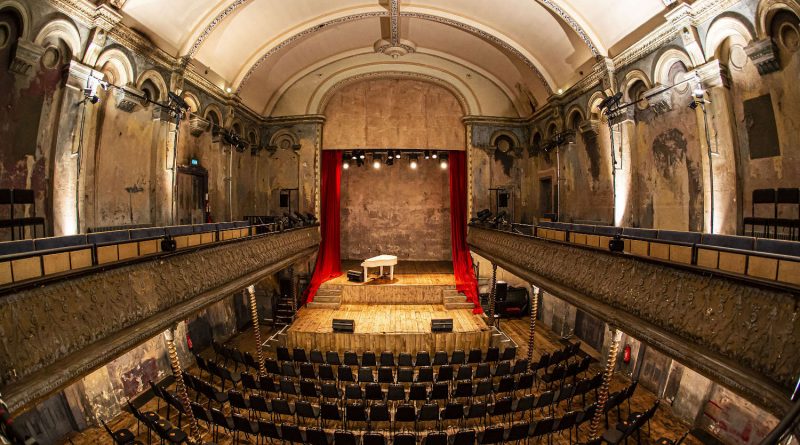The Everlasting Grandeur of Wilton’s Music Hall
Wilton’s Music Hall is a local favourite, with critically acclaimed performances such as The Rake’s Progress, lauded by Stephen Fry – and of course the annual Christmas show. The awe of walking through the red doors of this unassuming Victorian-era building into the faded glory of the hall does not cease, even on repeat viewings.
It’s also a popular filming location, including episodes of BBC’s Sherlock. But scratch the surface of Wilton’s faded wallpaper, and you will discover a venue that has been at the eye of the socio-political storm in the East End, bearing witness to landmark achievements for the working class, including the Match Girl strikes.
And throughout this time, Wilton’s has entertained working people and provided shelter for the poor, destitute and war-weary. Much like the East End, it has lived through and survived riots, wars and an ever-changing socio-political landscape.
Music halls are a Victorian form of entertainment dating back to the mid-18th century, growing out of small, impromptu singing rooms in local taverns. These pub-performances began to develop into grander venues, complete with a stage and intricate designs, under new ‘theatre licensing’ laws which came into effect in 1843.
Wilton’s Hall was built during this crucial period of 1850-1870, when the more ambitious ‘classic’ music halls emerged, and it was the vision of one John and Ellen Wilton.
Originally from Bath, John Wilton was a solicitor’s clerk who’d moved to east London with his wife Ellen for the sole purpose of taking over a pub called Prince of Denmark from its owner Matthew Eltham. This pub would become Wilton’s Music Hall.
It was Eltham who, in 1828, had added the iconic ‘Mahogany Bar’. This was the first example of a bar of this kind in Britain – a style that was quickly replicated. It became the quintessential Victorian pub-fitting, now ubiquitous across London and the UK.
After initial success as publicans, the Wiltons employed Thomas Ennor, a builder, to construct their first Music Hall. There are records from the Metropolitan Buildings Office from February 1853 that make reference to an ‘architect from Bath’ who was involved in the construction of a concert room in Whitechapel.
As the record didn’t specify what concert room it was, we can’t say for certain if it was Wilton’s. But it is likely this architect was Maggs of Bath. Then in 1855, architect S.C Aubrey of Dalston was then brought in to make further additions of stone staircases leading to the balcony and extended the hall.
The Wilton’s Music Hall surpassed anything on the scale of a concert room or saloon theatre – something that didn’t escape the notice of a visiting official. ‘…[This] is all intents and purposes a theatre,’ they noted. The Wiltons did not have a theatre license.
But pushing the boundaries of what the law around theatres would permit wasn’t unique to the Wilton’s at this time, though. Regulation couldn’t keep up with the progress being made by these ambitious, entrepreneurial publicans. Inspecting officials were finding that more and more pubs were making additions that went far beyond the simple concert rooms or saloon theatres of years past. The Music Halls that had emerged were different entities entirely.
This hall was successful enough for the Wiltons’ to acquire Numbers 2, 3 and 4 Graces Alley. They now had enough backyard space to build a grand venue. Their plan was coming together, and they were about to leave their indelible mark on the local landscape.
Jacob Maggs and the ‘Magnificent New Music Hall’
In 1858, they assembled a team of Ennor – the builder from the previous works – Jacob Maggs and S.C Aubrey, who this time assumed the role of supervising surveyor.
Wilton’s ‘Magnificent New Music Hall’ took just four months to build. At 75ft long and 40ft wide, it dwarfed anything that had previously been constructed on the site. The high stage had a large arch and high ceiling designed to create atmosphere. It was surrounded on three sides by an ornately decorated balcony, which was supported by ‘barley twist’ cast iron pillars.
Maggs had furnished the hall with mirrors, chandeliers and decorative paintwork. He employed White and Parlby to adorn the hall with decorative plaster and Homan (or Holman) to decorate in ‘subdued white’ and gold leaf. And he installed the finest heating, lighting and ventilation systems; state of the art for the day.
The most striking fixture was the colossal sun-burner chandelier that hung in the middle of the auditorium. Built by Jonas Defries & Sons of Houndsditch, this gargantuan lighting piece contained 27,000 cut crystals and 300 gas jets. It not only lit the space but provided forced air extraction due to the heat it generated. The chandelier burned with such intensity that charring is still visible in the rafters of Wilton’s Hall today.
Wilton’s Music Hall could now accommodate 1,500 people. It had space for supper tables, a benched area and promenades around the outside for standing customers. For punters of the day, it must’ve been a truly jaw-dropping experience to enter such a space. Especially when you consider it still retained the unremarkable pub entrance on Graces Alley – this was common at the time, even for music halls on Wilton’s scale, as street frontage was very expensive.
This contrast would’ve only added to the impact of entering such a grandiose and opulent auditorium. And the hall still provokes the same response from visitors today. New arrivals never cease to be impressed.
Famous acts at Wilton’s
Wilton’s welcomed many famous acts during this golden age of the music hall. The most notable being George Leybourne and Arthur Lloyd – the first two music hall stars to perform for royalty. Leybourne is the best known of the two. His song ‘Champagne Charlie’ was incredibly popular on the circuit.
Wilton’s is also credited with putting on the first female rendition of the can-can outside of France. Despite booking these landmark acts, though, the theatrical tide was changing in favour of the West End. And the Wiltons followed the money. They sold up in 1868 and opened a West End restaurant.
Fire and passing into obscurity
The music hall changed hands several times over the next thirteen years. Disaster then struck in 1877 during a refurbishment,when a fire ripped through the hall, leaving only its basic structure. Whilst what caused the fire is unknown, at one time or another, nearly every music hall in London has succumbed to a blaze.
This wasn’t the end of the road, though. Like the phoenix, Wilton’s would rise from the ashes. The hall was rebuilt just a year after the fire, with hardly any changes to the 1859 design. It continued to operate as a music hall until 1881, when it closed, likely due to a failure to meet the new fire regulations brought in that year.
The East End Mission, strikes and The Battle of Cable Street
The East End during the late 1880s was renowned for its squalid conditions. People were poor and destitute. Crime was rife among east London’s warren-like streets and alleyways – in what was then the richest nation on earth.
Whitechapel was particularly affected. Civil unrest constantly threatened to boil over into pitched street battles between residents and police, further exacerbated by the authorities’ apparent inability to contain the murdering spree of a certain ‘Jack the Ripper’.
It was because of all this that religious groups stepped in to help. The East London Methodist Mission was one such organisation. They bought Wilton’s Music Hall in 1888 and renamed it ‘The Mahogany Bar Mission’. During the Great Dock strike the following year they set up a soup kitchen at The Mahogany Bar, feeding thousands of meals a day to starving dockers’ families until the strike ended successfully.
The strike initiated the growth of workers’ unions, and drew attention to the growing problem of poverty in Victorian Britain. The Mahogany Bar Mission also played a similar role during the infamous Matchgirls’ strike.
Fast-forward to 1936 and The Mahogany Bar Mission once again assumed front-stage during a defining political event. The Battle of Cable Street, as it came to be known, was the violent confrontation between the British Union of Fascists ( known as the Blackshirts), led by Oswald Mosley, and various loosely organised anti-fascist demostrators.
The Metropolitan Police, originally sent to protect the fascist marchers, also became embroiled in the violence. The Mission took in injured parties from all sides of the clash, seeing to their wounds and acting as a safe space.
Throughout The Mission’s tenure at Wilton’s Music Hall. They campaigned against social abuses, welcomed people of all ethnicities, and supported the local community, particularly the needy children of the area.
The Blitz and the post-war period
The Blitz had taken a heavy toll on the East End. Many residents and businesses had left the area to escape the bombing raids. And having provided children’s clubs throughout the conflict – designed to take their minds off of the war – The Mahogany Mission also left in 1956, ending their 70-year ownership of Wilton’s.
The 1960s brought the era of redevelopment. The London City Council (LCC) drew up plans for a demolition of the whole area between Cable Street and Ensign Street, to make way for new residential properties. Wilton’s was once again on the brink of extinction, having barely existed as a rag-sorting warehouse for the previous five-or-so years.
However, in 1964 the building was once again spared, owing to a tenacious campaign led by theatre historian John Earl, poet John Betjeman and the British Music Hall Society. The building was subsequently bought by the Greater London Council (formerly LCC) who agreed to leave it standing.
The plight of Wilton’s had entered the public consciousness by the early 70s, in part due to comedian Spike Milligan putting on a BBC special staged at Wilton’s. This resulted in the building being Grade II* listed in 1971. And by 1972, the building had changed hands again following the establishment of a trust fund by John Earl and Peter Honri, an actor and music hall historian, to buy the lease from the GLC.
90s rebirth
By the early 90s the building began to attract the attention of artists thanks to its uniquely ethereal yet desolate atmosphere. The building was used for film and video shoots, including Richard Attenborough’s Chaplin in 1992, Frankie Goes to Hollywood’s Relax in 1984 and Annie Lennox’s No More I Love Yous in 1995.
More recently the venue served as a filming location for an episode of BBC’s Sherlock and the 2014 film Muppets Most Wanted. Before these two later productions, though, Wilton’s still found itself in a precarious state of dereliction, with many rooms unsafe for public access, despite renewed interest in the arts scene.
It wasn’t until 2012 that enough money was raised to carry out the initial phase of repairs to the auditorium. SITA Trust, the Foundation for Sport and the Arts, and many other trusts and individuals donated just over a million pounds to make this happen.
A policy of ‘conservative repair’ was observed throughout the renovations, which placed heavy emphasis on ‘retaining genuine historic fabric and avoiding misleading restoration, so that future generations can interpret the significance for themselves in their own way, based on the physical evidence’. This approach was instrumental in the works receiving many awards for building conservation when repairs finished in 2016
Current cultural standing
Wilton’s now showcases theatrical productions and critically acclaimed performances. But it’s perhaps the building itself that tells the most dramatic tale.
It’s a story of rising again and again. Its indomitable spirit has allowed Wilton’s to have a positive influence during some of the area’s most testing times over the past 150 years. It’s a building as bold and unrelenting as the East End itself.






If and when the quarantine ends will tours be offered of the hall?
I wish you success. I do not wish to become a supporter on a monthly basis, as I live in the U.S. and don’t get to your part of the world regularly; but if you have a one-time donation link I would participate.